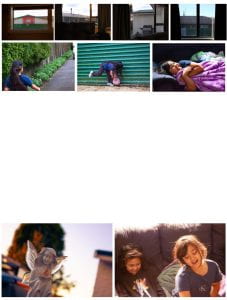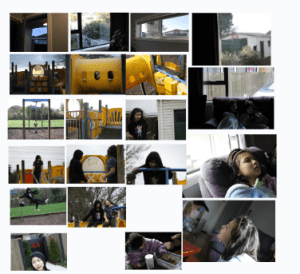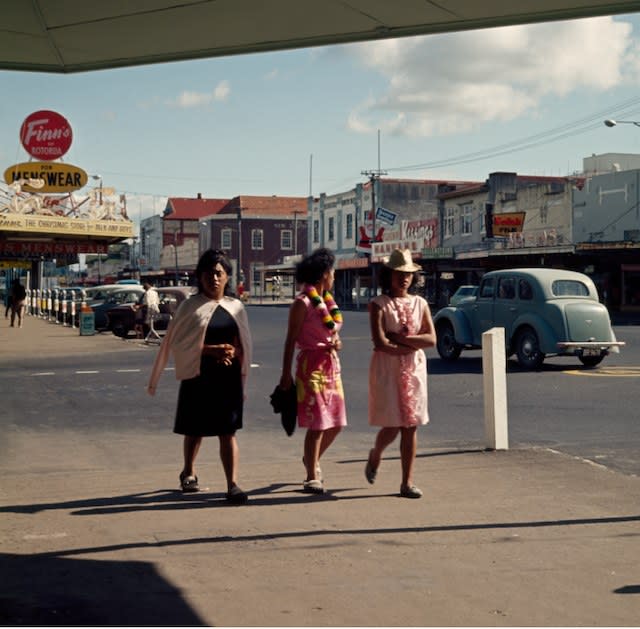https://docs.google.com/document/d/1d_9ksKquIxEITax-kGiu392-SydmAQ4jojwTU2E-DYY/edit?usp=sharing
In photography, I am currently working on my portfolio. My kaupapa is the fun/joy of my two nieces going outside and playing outside.
I am currently working on arranging my photographs around to correctly convey my kaupapa.
At this point in time, I have it arranged so that the top row of my folio is four photos capturing the view from inside, showing the view from the windows. (These photos are currently unedited).
The next three photos underneath, shows Roya, the first two outside and the third her laying down inside. We can see the leading lines lead you along the images. I have edited these images to have higher contrast and made other slight changes to the colour and lighting.
The bottom left image captures an angelic statue, with an orange tint throughout the whole image, on the bottom right we see my two nieces sitting on the couch, edited to have the same orange tint in the angel statue image. The angel statue helps portray the innocence and angelicness of these two kids. By putting these two together it helps portray the narrative.

These photos under here are currently not put on my board, I am planning to put a majority of these on my second panel and reshoot the in-betweens.

Notes about Edith Amituanai’s photography.
How can I implement Edith Amituanai’s techniques into my photography?
I want to try to tell a narrative with my photos, a story or some sort of message. With my current folio piece, this narrative is about kids going outside to enjoy their time on the playground, then coming back inside to calm back down. We first see the view of the outside world from in, then we see the kids venture into the backyard and the playground, and last we see them back inside this time not looking out, but resting inside.
I should keep my photos relatively simple, not have many unnecessary distractions and keep the essential aspects as the main focus. I could take more wide-angled shots, and show more of the environment to give more context.


In this shoot, I was attempting to capture the idea of kids looking outside, anticipating the joy of playing outside and the excitement of the fresh air. I still would like to improve on these photos, although I am not quite sure how yet, perhaps I can be slightly more experimental with my shooting techniques.



This is a peer critique of my third photo shoot, in this photoshoot, I attempted to emulate aspects of Ans Westra’s photography. I did this by trying to capture the pure unfiltered moments of life, making sure to not interfere with what my subjects are doing.
In the photos shown, I did a peer critique with Cody Weastell. These photos have been digitally altered by Cody on Photoshop. I then critiqued these photos by giving feedback and stating what I thought he did well and what he could improve on.

This picture has two very juxtaposing portions, the left side has less saturated and dull colouring, while the right side has more saturated and brighter colouring. I like how the focus of the image is the pathway leading down to the centre of the image. Very busy image, colour-wise and just in general.

This image has predominantly less saturated colouring, with a few bits of blue spread throughout. I like how there are portions of the road missing from the image, leaving a lot of impactful negative space around the image. The reoccurring green throughout the image also helps provide some consistency. The trees in the background are also used effectively to create some varying proportions and uniqueness. The road is also used effectively to help give a sense of a warped perspective.

With this image, we can see clearly that the red building is the focal point of this image. I also like how the fence leads you from the left side to the right side of the image, and the different levels of exposure in certain parts of the photo make it stand out.
Overall
All of these images clearly emulate David Hockney’s style of photography. One suggestion I will make is that next time you should take a larger amount of photos, in order to be less constricted by the current ones you have, you could even take them on different days to create contrasting elements such as different weather, lighting, and other variables such as if a person is walking by, or an animal.
I have begun my work on my portfolio piece for the level 2 photography assessment. At this point, I have been gathering photos I have taken previously and formatting them to form a rough series. I will have to perform multiple reshoots to perfect the folio.
So far I have the kaupapa of (simply put) my niece going outside and then coming back in. The first part I will reshoot is the photos of “looking outside from in” I will use framing and other techniques to my advantage to help portray this message.

Name: ROTORUA, [THREE WAHINE]
Artist: Ans Westra
Date: 1963
Media: Archival pigment inks on Ilford Galerie gold fibre silk
Size: 380 x 380 mm

P This is photography using archival pigment inks on Ilford Galerie gold fibre silk, taken in 1963. This is candid photography due to the subjects in the photo not seeming aware of the photograph and just naturally walking through the streets.
P Ans Westra uses Archival pigment inks on Ilford Galerie gold fibre silk, this type of printing may have been used for a plethora of reasons, such as superior longevity to other types of printing, higher image quality, being more suitable for large format printing, and for being compatible with a wide range of media types. Candid Photography is also used, this is when a photo is taken naturally without being staged, in this case, the three women here are walking down the street and are not posing, and don’t seem aware of the photographer taking their picture.
M Ans Westra spent the majority of her photography career taking documentation of Māori culture, by living in New Zealand and educating herself about the culture. This has helped her portray realism and spontaneity in her photographs. Ans Westra herself is not from New Zealand, she was born in Leiden, Netherlands in 1936 and immigrated to New Zealand in 1957. Her being an immigrant woman herself yet treating the Māori people with as much respect as anyone deserves, she doesn’t look down on them or see them as less than her. This shows in her photography as you can see the real, unfiltered life of Māori people in New Zealand.
T This artwork (along with all her other photographs) has been digitised to preserve her work, this means this photograph will not be the same as the darkroom process, an may look slightly different to what Ans Westra intended.
Subject Matter!
I will incorporate my second artist by emulating the candid photography Ans Westra uses and the themes of unfiltered, real moments she has in her work. The people I am planning to capture photos of are my two nieces.

In this shoot I attempted to emulate Ans Westra, I did this by trying to capture the perfect moment of my two Nieces living their life.







Peer Critique of my work – https://hhscodyw.edublogs.org/2023/06/19/peer-critique-aryan-masoumi/
This is a peer critique of my second photo shoot, in this photoshoot, I attempted to emulate aspects of Duane Michals’s photography. I did this by trying to capture the feelings of loneliness and isolation that are present within his series Empty New York, I attempted to emulate this feeling by taking photographs of areas that would usually be expected to have people present, but empty. Around the end of the photo shoot, I also got the idea of taking some photos of some abandoned / run-down areas, capturing the feeling of Duane Michals’s photos in a sense that someone used to be there, but now contains no sign of human life.
Peer Critique of my work – https://hhscodyw.edublogs.org/2023/06/09/peer-critique-written-work-aryan-masoumi/
This is a peer critique of my first photo shoot after I had edited it in Photoshop, in these edits, I attempted to emulate aspects of William Eggleston’s photography. I did this by enhancing the vibrance, and saturation, and just adjusting the overall features of the photograph.